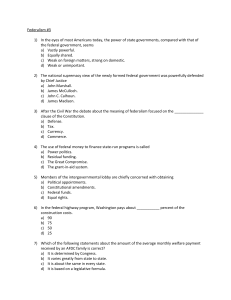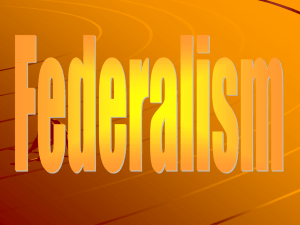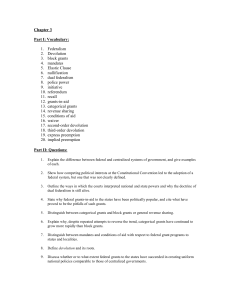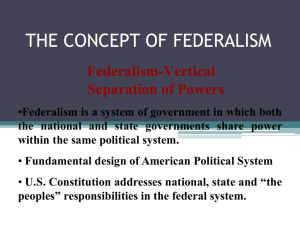AP-US-Gov.-Ch.
advertisement
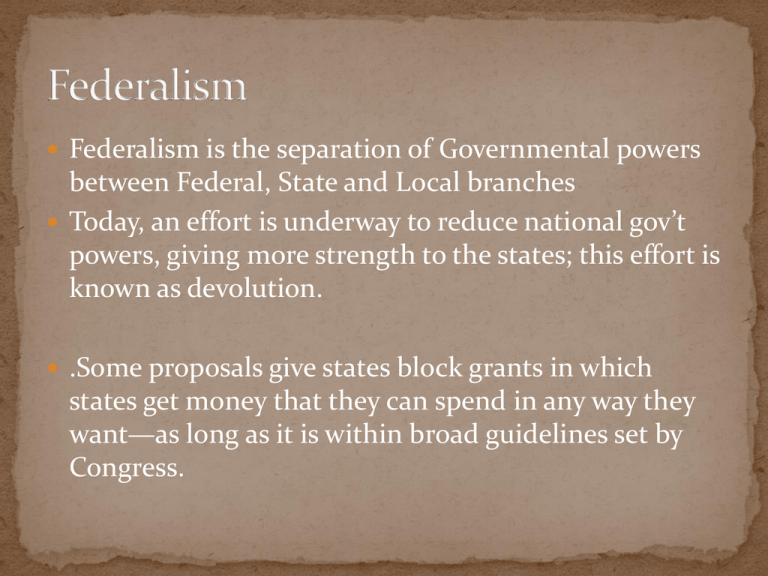
Federalism is the separation of Governmental powers between Federal, State and Local branches Today, an effort is underway to reduce national gov’t powers, giving more strength to the states; this effort is known as devolution. .Some proposals give states block grants in which states get money that they can spend in any way they want—as long as it is within broad guidelines set by Congress. Unitary government: a) all local governments are subservient to the national government b) local governments can be altered or abolished by the national government c) local governments have no final authority over any significant government activities federalism allows states to block actions, prevent progress, upset national plans, protect powerful local interests, and cater to the self-interest of hack politicians; to others, it means developing mechanisms vital to governmental strength, political flexibility, and individual liberty Federalism allows people to pass laws according to local interest, and even though some may pass bad laws, others may pass laws to counteract the previous “bad” laws. The Founders envisioned federalism as a system in which both national and state governments would have certain powers, but neither would have supreme authority over the other. 1.In Federalist No. 46, Madison argued that state and national governments were simply different agents and trustees of the people, who held the ultimate power. 2.In Federalist No. 28, Alexander Hamilton explained that, in federalism, people would shift their support between national and state governments to keep the two in balance. The 10th Amendment that, states actually received power; in that amendment, all power not given to the national gov’t are given to the states. On the other hand, it seems that the national government has usually retained these “other powers” anyway, despite what is said, due to support from the courts. The language used to describe national/state government relationships was vague, and it was later left up to the courts to interpret it. Knowing that they could not possibly list every single power that Congress could have, the Founding Fathers added the elastic clause: “Congress shall have the power to make all laws which shall be necessary and proper for carrying into execution the foregoing powers.” Alexander Hamilton believed that the national government was the superior and leading force in political affairs, since the people created it and its laws were the “supreme law of the land;” Hamilton believed that the Constitution could be loosely interpreted Thomas Jefferson believed that “the people” were the ultimate sovereigns, and since the constitution was a result of agreement among the states, the states were supreme over the national gov’t. Jefferson believed in a strict interpretation of the Constitution In McCulloch v. Maryland, James McCulloch, a Baltimore cashier of the Bank of the United States, refused to pay the taxes that the state of Maryland levied on money and was jailed. 1.Marshall ruled that Maryland had no right to tax the notes of national currency, and thus, McCulloch had the right not to pay a tax that wasn’t supposed to be levied. 2.That ruling also firmly strengthened the “necessary and proper” (elastic) clause. In response to the Alien and Sedition Acts, James Madison and Thomas Jefferson wrote the Virginia and Kentucky Resolutions, stating that states had the right to “nullify” laws that, in the state’s opinion, violated the Constitution, thus presenting the concept of nullification. John C. Calhoun later revived this doctrine, and the ensuing battle later led to the explosion of the Civil War. The doctrine of Dual Federalism emerged after the Civil War; it stated that though the national gov’t was supreme in its sphere, state governments were supreme in theirs as well, and that these two spheres should be kept separate. 1.This applied to commerce: Congress could regulate interstate commerce, but states regulated intrastate commerce. The best illustration of how political realities may affect legal authority can be found in federal grants-inaid, where the national gov’t granted land or money to various people or places for helpful use. At first, cash grants weren’t plentiful, as they were usually devoted to helping state militias or such, but in the 20th century, these exploded, and today, housing aid fro low-income families, Medicaid, highway construction, services to the unemployed, and welfare programs for single mothers and for the disabled take up a huge chunk of grants-in-aid. Reasons for states’ turning to Washington for $$$: (1) There was a lot of it (in the 1800s, there were lots of surpluses); (2) The federal government had an income tax that could generate revenue; (3) The federal gov’t could print more cash whenever it needed it and only had to borrow from itself; (4) Politics—federal money seemed to be “free” money for states. Meeting national needs 1. 1960s shift in grants-in-aid a) From what states demanded… b) …To what federal officials considered important as national needs c) Meanwhile, state and local governments had become dependent on federal funds 2.To fix this, intergovernmental lobbies have been set up to seek national aid for cities & states 1. Hundreds of state, local officials lobby in Washington 2. Purpose: to get more federal money with fewer strings 3. By 1980, however, federal funds had stopped growing Neither block grants nor revenue sharing achieved the goal of giving the states more freedom in spending 1. Categorical grants are for specific purposes defined by federal law; they often require local matching funds 2. Block grants (sometimes called special revenue sharing or broad-based aid) were devoted to general purposes with few restrictions—states preferred block to categorical grants 1. Federal officials, liberal interest groups, organized labor tend to distrust state government; categorical grants give the national government more power 2. No single interest group has a vital stake in multipurpose block grants, revenue sharing 3. Categorical grants are matters of life or death for various state agencies 4. Supervising committees in Congress favored growth of categorical grants 5. Revenue sharing was wasteful because it was so widely distributed that it did not reach those with greater need in sufficient amounts A. Mandates 1. Mandates: federal rules that states or localities must obey, not necessarily linked to funding a) Civil rights b) Environmental protection Conditions of aid are purely optional (don’t want restrictions, don’t take money), but since much of the state budgets depend on federal grants, these conditions are often taken anyway 1.President Richard Nixon tried to reverse this by creating block grants and revenue sharing. 2.President Ronald Reagan tried to stop this by combining 33 categorical grants into six large block grants, but Congress attached restrictions to many of the new grants. 3.Thus, the cutbacks in money during the 1980s led to many states experimenting with new ways of delivering services. There are three type of block grants: operational grants are for purposes like running state child care programs; capital grants are for purposes like building local wastewater treatment plants; entitlement grants are for purposes like transferring income to families and individuals. All of the block grants that existed before the 104th Congress convened were operation or capital only, and thus, the 104th Congress enacted a large number of entitlement grants. 1.Welfare (Aid to Families with Dependent Children) and Medicaid were not created as block grants, though they account for half of all federal grant-in-aid spending. 2.However, the 104th Congress tried to turn these two in block grant programs. 3.Welfare did turn into a block program, but Medicaid did not.
